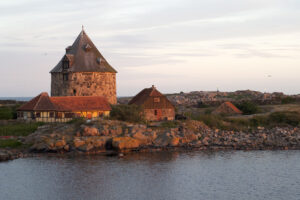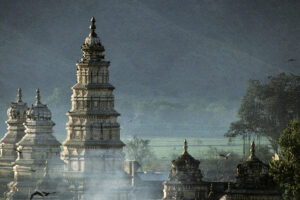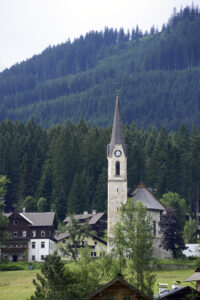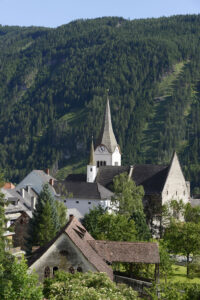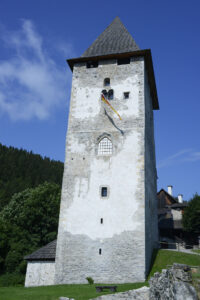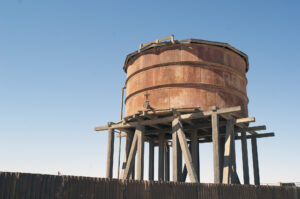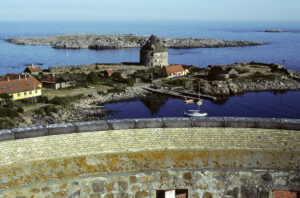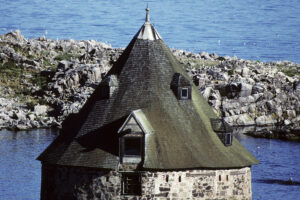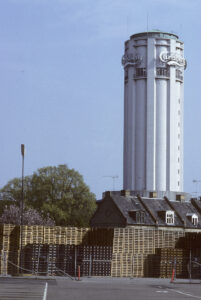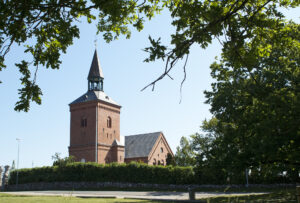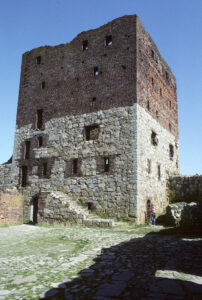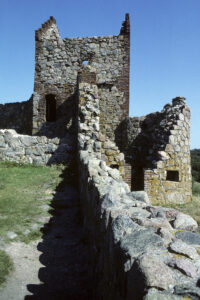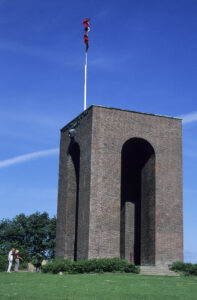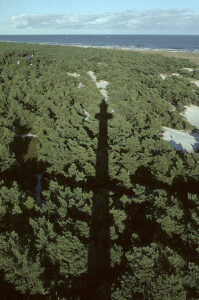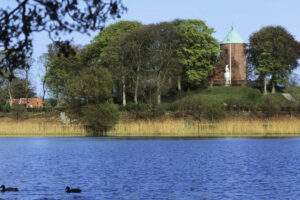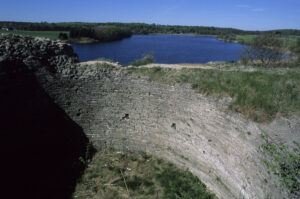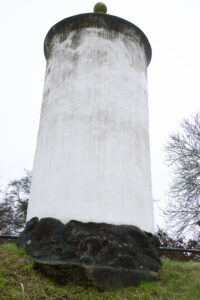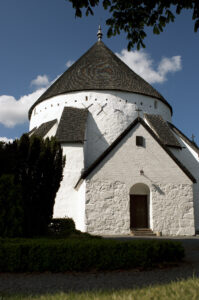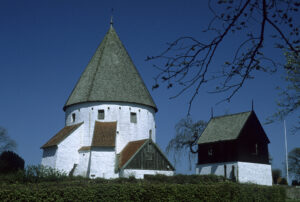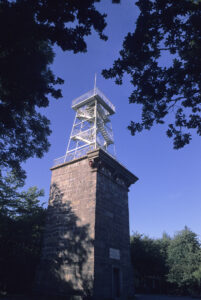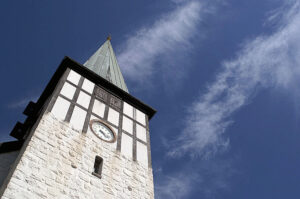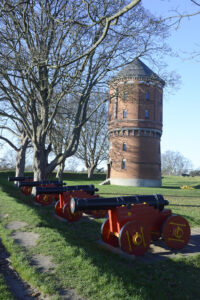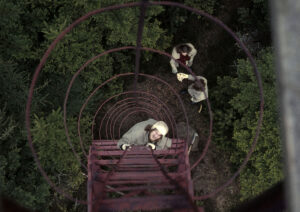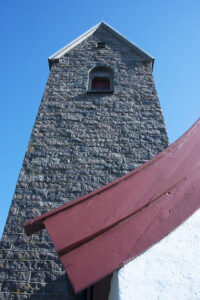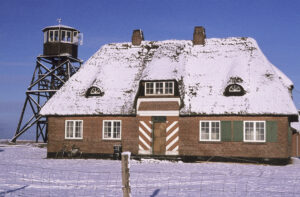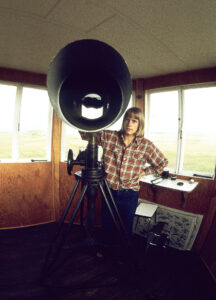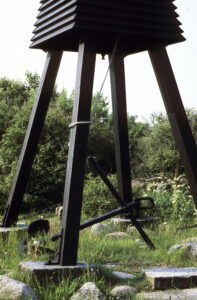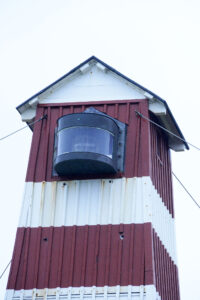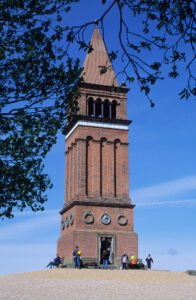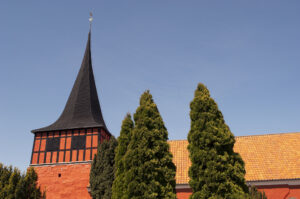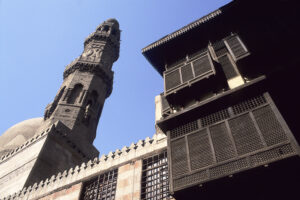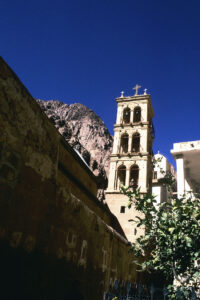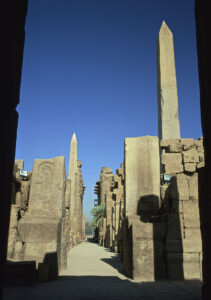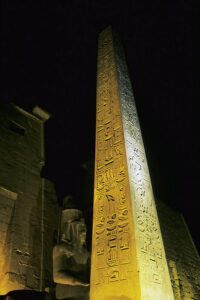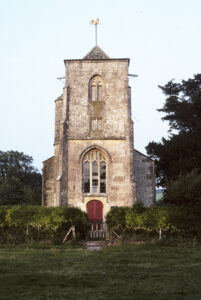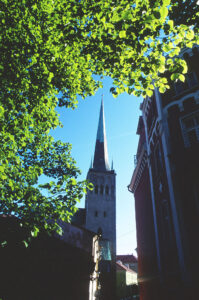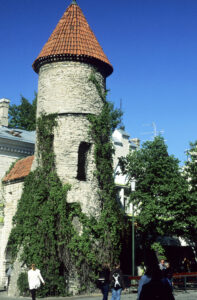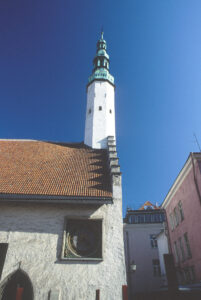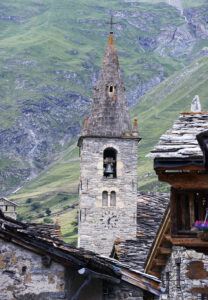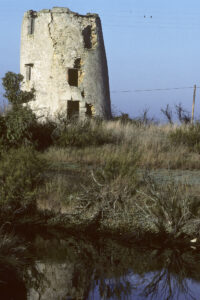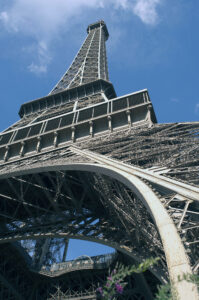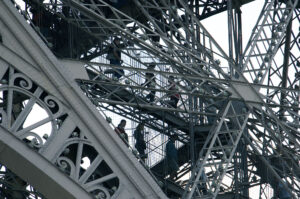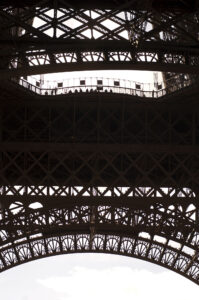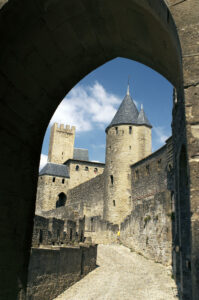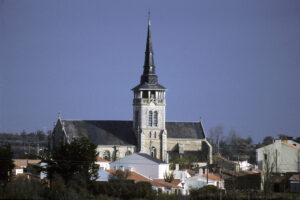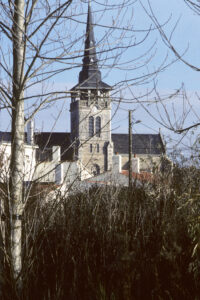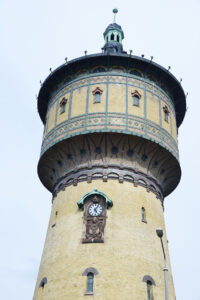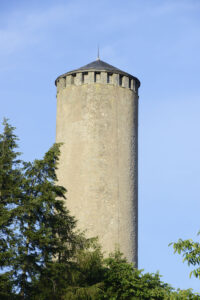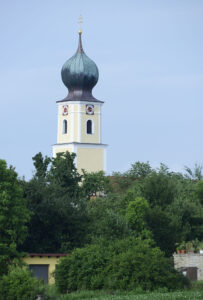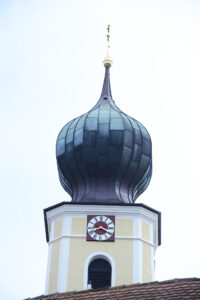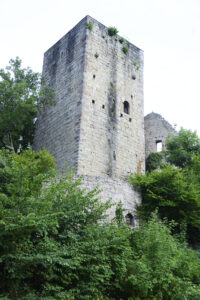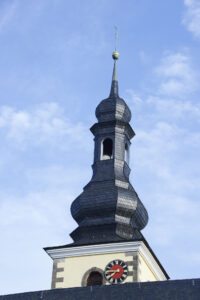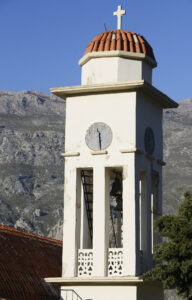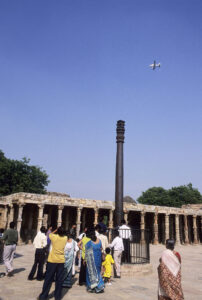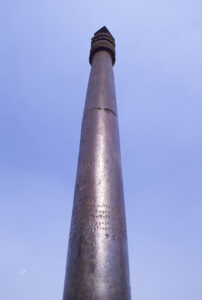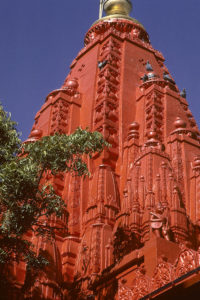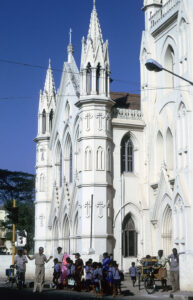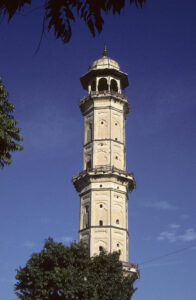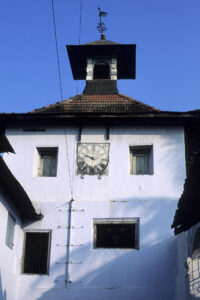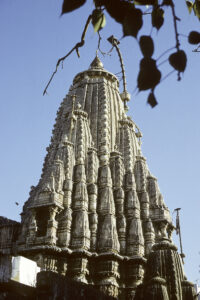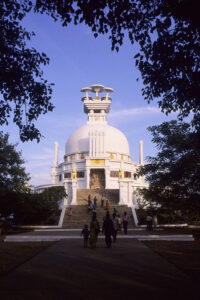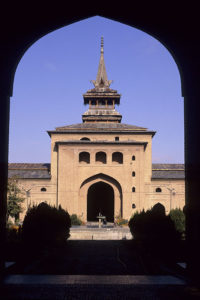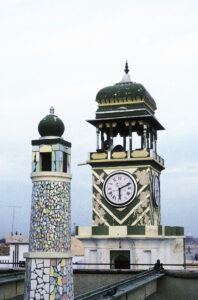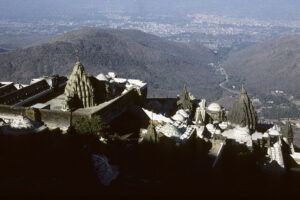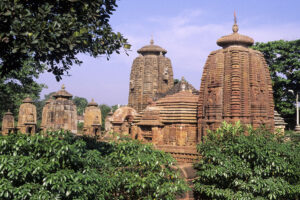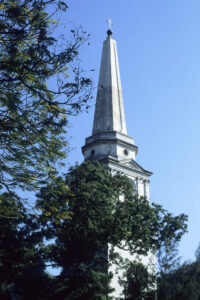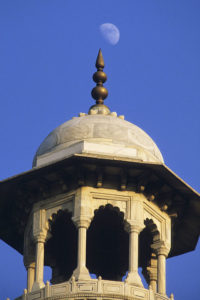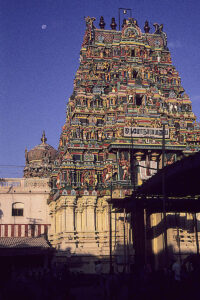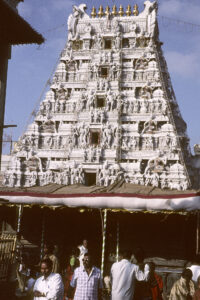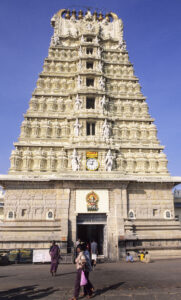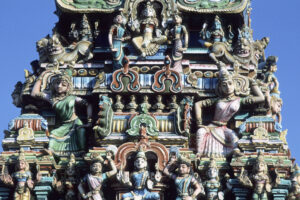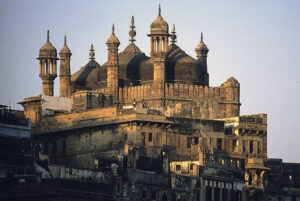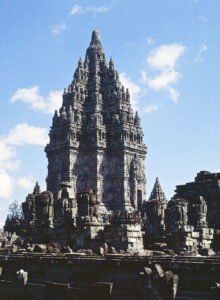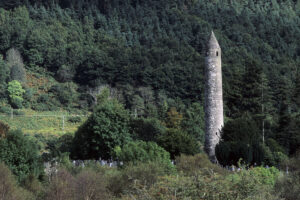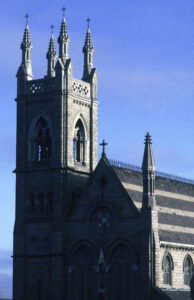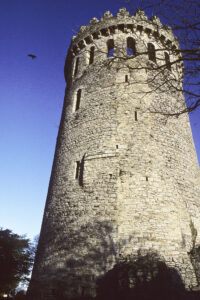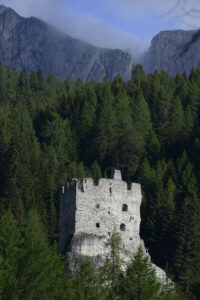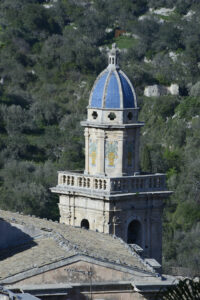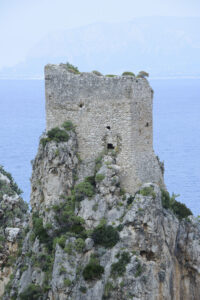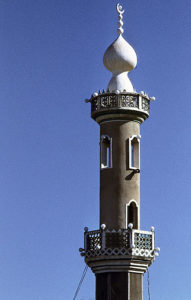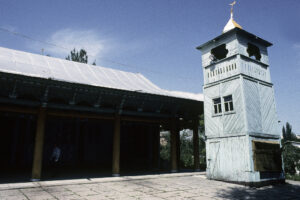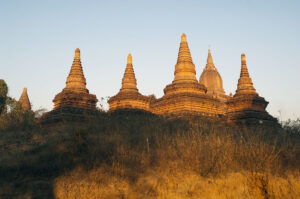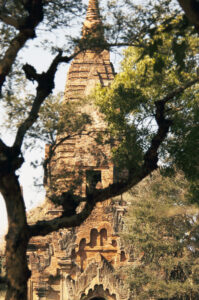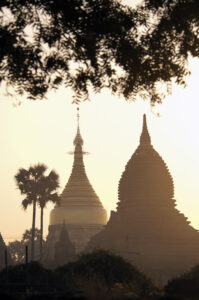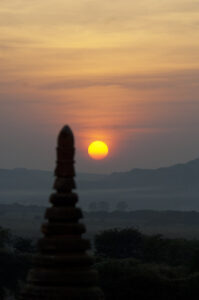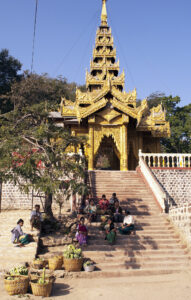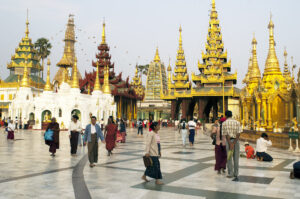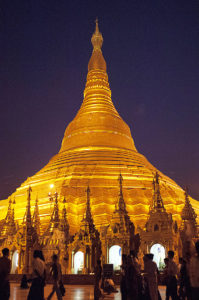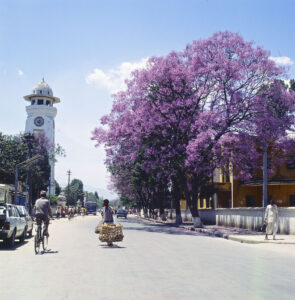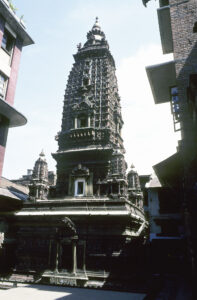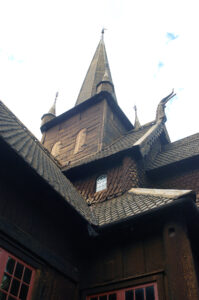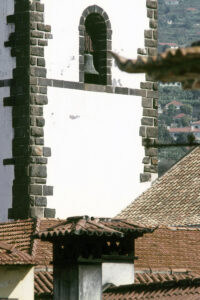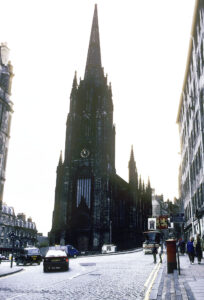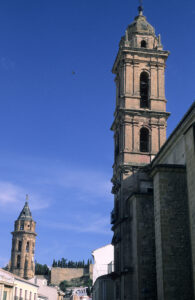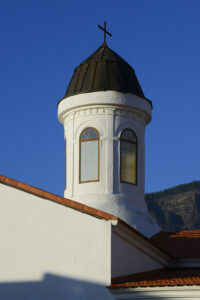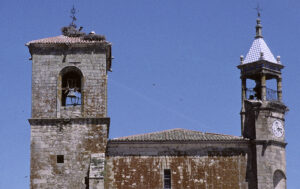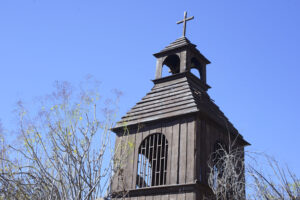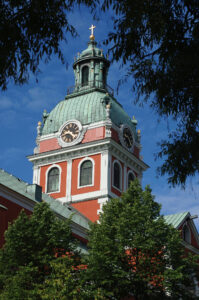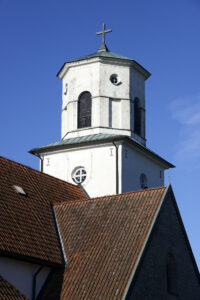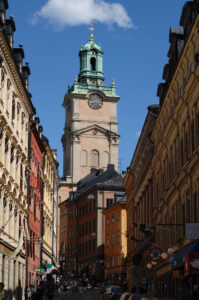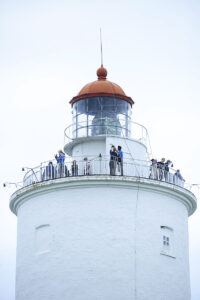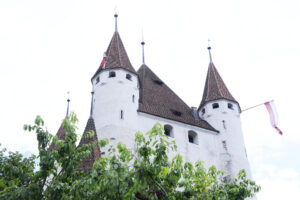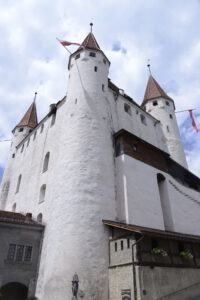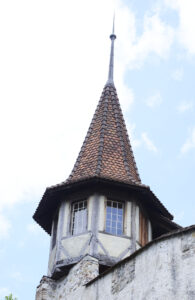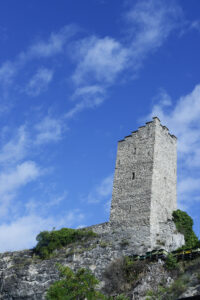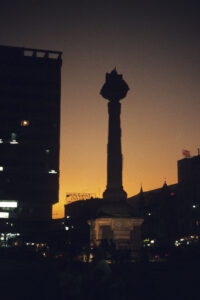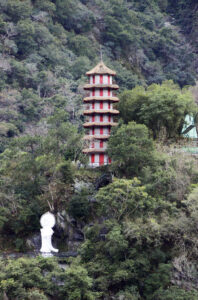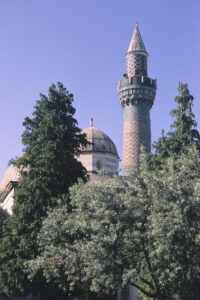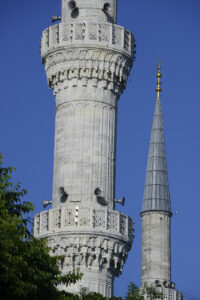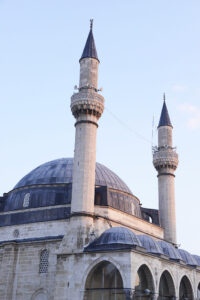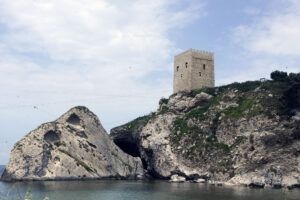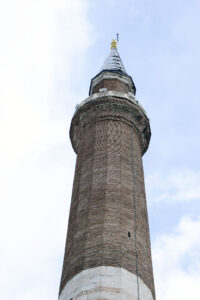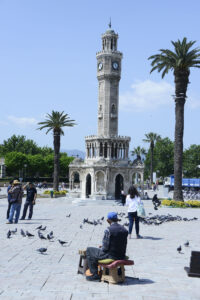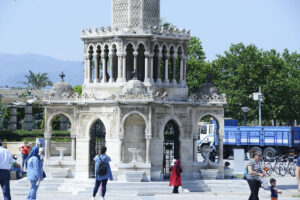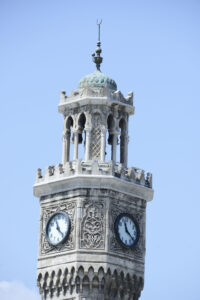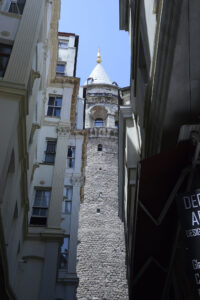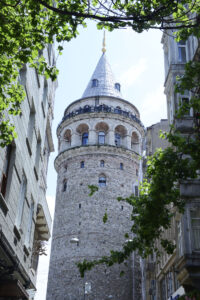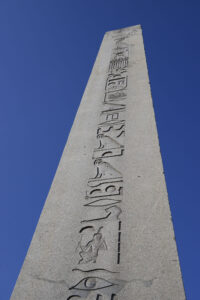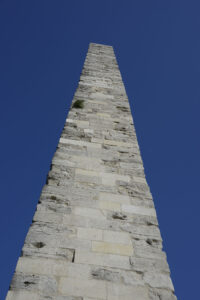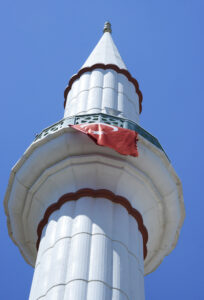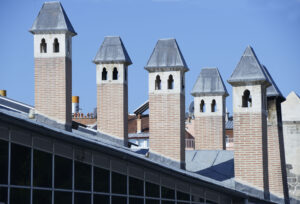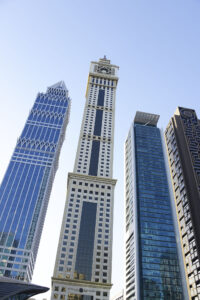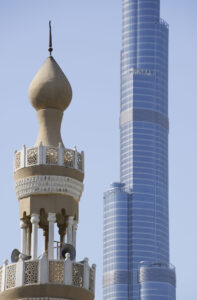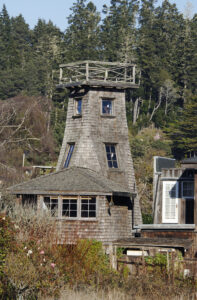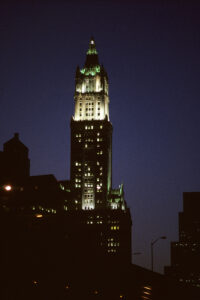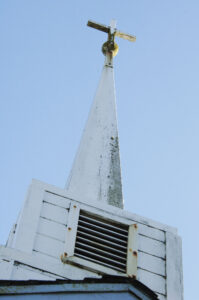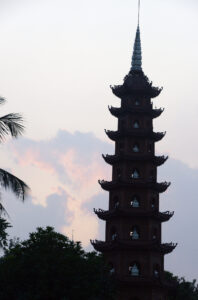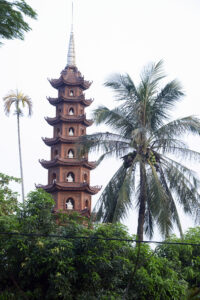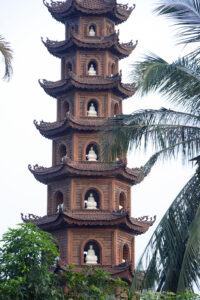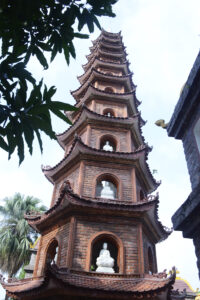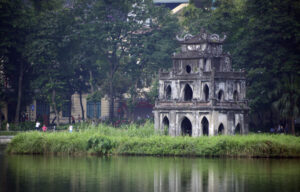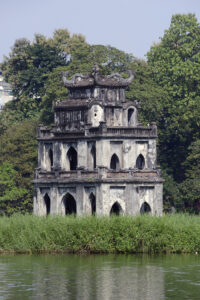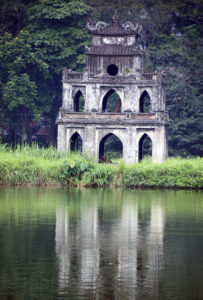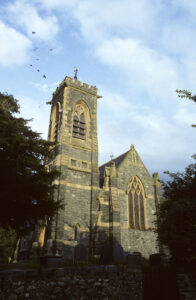Towers and spires
Morning light on Lilletårn, Frederiksø, Bornholm, Denmark, built as an observation tower during the Danish-Swedish wars in the 1600s. (Photo copyright © by Kaj Halberg)
Hindu temples in morning mist, Pushkar, Rajasthan, India. (Photo copyright © by Kaj Halberg)
Towers in the town wall, Tallinn, Estonia. (Photo copyright © by Kaj Halberg)
Early morning around Sultanahmed Camii, popularly called ‘The Blue Mosque’, Istanbul, Turkey. This gorgeous mosque was erected during the rule of Sultan Ahmed I (1603-1617). (Photo copyright © by Kaj Halberg)
Towers and spires occur in all kinds of shapes and forms. A selection is presented below, arranged alphabetically according to country.
Austria
Church tower in a village near Gosau, Upper Austria. (Photo copyright © by Kaj Halberg)
St. Martin in Murau-Murtal, Oberwölz, near Sankt Peter am Kammersberg, Steiermark, is a Romanesque church, dating back to around 1007. In the 1600s, a fire destroyed the glass windows, the bell tower and the roof of the church, and the repairs completely changed its overall impression.
St. Martin in Murau-Murtal, Oberwölz. (Photo copyright © by Kaj Halberg)
The ruined castle Petersberg, Friesach, Steiermark, dates back to around 860 and was enlarged several times during the following centuries. The complex was largely destroyed by fire in 1673, and as it was no longer of military importance, it was abandoned and fell into disrepair.
A tower in castle Petersberg. (Photo copyright © by Kaj Halberg)
This monument with a spire, in the centre of Kufstein, Tirol, is called Marienbrunnen, a well dedicated to Virgin Mary. (Photo copyright © by Kaj Halberg)
Chile
Water tank in Officina Chacabuco, a deserted mining town north of Carmen Alto. (Photo copyright © by Kaj Halberg)
Denmark
In the 1600s, a number of wars were fought between Denmark and Sweden. The Danish King, Christian V, ordered a fortress erected on two tiny islets near the island of Bornholm, in the Baltic Sea, south of Sweden. Construction took place 1684-1687. These islands, which had until then been uninhabited, were named Christiansø, in honour of the king, and Frederiksø, in honour of his successor, Frederik IV.
Lilletårn (‘Little Tower’) on Frederiksø, seen from the fort Storetårn, on Christiansø. Both of these buildings were constructed as a means of defence during the Danish-Swedish wars in the 1600s. In the background the bird sanctuary Græsholmen. (Photos copyright © by Kaj Halberg)
This 70-m-tall building in central Copenhagen is known as the ‘Carlsberg silo’. Originally, it was constructed in 1956-1957 by Kongens Bryghus (‘Royal Brewery’) as a storage building for malt, but was only used for 13 years, until the breweries Carlsberg, Tuborg, and Kongens Bryghus merged to form De Forenede Bryggerier (‘United Breweries’). The silo stood empty for many years. Initially, a large logo, KB, was found near the top of the building, later changed to another logo, Carlsberg, which was removed when apartments were built in the silo 1994-1997.
The Carlsberg silo, as of 1993. Since then, the logo has been removed, and apartments have been built in the tower. (Photo copyright © by Kaj Halberg)
Bregninge Church is situated on top of a hill named Bregninge Bakke, on the island of Tåsinge, Funen. It stems from about 1100, when apse and nave were erected, using boulders. Presumably, before the introduction of Christianity, the hill was a sacrificial place, dedicated to the Norse god Thor.
Bregninge Church, Tåsinge, Funen. (Photo copyright © by Kaj Halberg)
Hammershus (’House of Hammeren’, named after a local rocky outcrop), on the island of Bornholm, in the Baltic Sea, is the largest castle ruin in northern Europe. Construction began some time during the 1200s, initiated by Anders Suneson, archbishop of Lund, in Skåne, which in those days was a part of Denmark (today a part of Sweden). A later archbishop, Jakob Erlandsson, and the Danish King, Christoffer I, were rivals, struggling to gain power, as the most powerful of the two had the right to tax the people, and thus become rich.
Over the years, the castle fell into the hands of the Lübeckers and the Swedes, but was recaptured by the Danes. When it lost its strategic importance, it functioned as a prison for some years, but was then abandoned. A large part of it was used for construction of other buildings, until the rather poor remains were protected in 1822.
In this square tower, named Manteltårnet, enemies of the king were imprisoned. (Photo copyright © by Kaj Halberg)
Ruins of Blommetårnet, a watch tower. (Photo copyright © by Kaj Halberg)
Ejer Bavnehøj, south of Skanderborg, Jutland, is the third highest hill in Denmark, at 170.35 m only a fraction lower than the nearby hills Møllehøj and Yding Skovhøj. The name ‘bavnehøj’ informs you that the hill in former times was utilized as a place, where a fire (‘bavn’) was ignited, when enemies were approaching.
When the Germans lost WWI, southern Jutland was re-united with Denmark. To celebrate this historical event, a memorial stone was erected in 1920 atop Ejer Bavnehøj. In 1924, the stone was replaced by a 12.5 m tall tower, called Genforeningstårnet (‘Re-union tower’).
Today, the tower on Ejer Bavnehøj is a major tourist attraction, as there is a fine view from it. (Photo copyright © by Kaj Halberg)
The tallest lighthouse in Scandinavia is situated at Dueodde, the southern tip of the island Bornholm, in the Baltic Sea. This lighthouse is 47 m tall, built 1960-1962. The foundations of this building rests on 19 concrete pillars, reaching a depth of 14 m. It has a 1000-watt lamp, the light of which is amplified 200 times by a French lens from 1886 with a rotating set of prisms, reused from an older lighthouse.
This older lighthouse, erected in 1880, was 38 m high, situated inland, so that its foundations could rest on solid granite. It was supplemented with a smaller, only 15 m tall lighthouse further south. This southern lighthouse soon became inadequate due to a pine forest, which was growing too tall.
In 1936, the remaining unvegetated dunes at Dueodde were protected, the largest one still migrating 3 or 4 m a year.
Dueodde Lighthouse, seen behind a migrating dune with marram grass (Calamagrostis arenaria). (Photo copyright © by Kaj Halberg)
The shadow from Dueodde Lighthouse is cast on a pine forest, covering the dunes. (Photo copyright © by Kaj Halberg)
Previously, Slotsholmen was a small island between Lake Skanderborg and Lillesø (‘Little Lake’), but today it is connected to the shore. On this island, a fortress, Skanthorpburg, was constructed in the Middle Ages, presumably in the 1100s. The fort got its name from a nearby small village, Sklandethorp or Skanderup.
In 1561, King Frederik II (1534-1588) let the dilapidated fort tear down, and a flashy renaissance castle was erected in its place. In 1572, a chapel was installed in one of its wings. His son, Christian IV (1577-1648), changed the castle to a fortress, with earthen batteries, palisades, and thick walls. The many wars in the 1600s took their toll on the castle. It was abandoned as a royal residence, and soon went into disrepair. Only the church remained in fairly good shape.
In the period 1717-1722, King Frederik IV (1671-1730) let the castle rebuild. All parts of the Middle Age castle were torn down except the tower. However, the following kings had little interest in the castle. It was sold in 1767 to civil servant Hans Lauritzen, who let it tear down. Only the castle church remained, functioning as a place of worship for the 500 inhabitants of Skanderborg.
Skanderborg Slotskirke (‘Skanderborg castle church’). (Photo copyright © by Kaj Halberg)
The Bastrup Tower is a ruined fortress, situated near the shore of Lake Bastrup, northern Zealand. Presumably, this solid building, with 6 metre thick walls and a diameter of 21 m, was constructed in the first half of the 1100s by order of Ebbe Skjalmsen, also known as Ebbe de Bastetorp, an uncle of Bishop Absalon.
The Bastrup Tower and Lake Bastrup. (Photo copyright © by Kaj Halberg)
The tower in the picture below, in the city of Nyborg, is popularly known as The White Virgin. According to local folklore, a maiden named Rigmor Brockenhuus was bricked-up in the building. Her father, Laurits Brockenhuus, was fief man at Nyborg Castle 1579-1601. Rigmor ‘got into trouble’ in a love affair, and as a punishment she was ‘bricked-in’, i.e. she had to live in isolation in Egeskov Castle, Funen.
(Photo copyright © by Kaj Halberg)
Seven round churches exist in Denmark, five of these on the island of Bornholm, in the Baltic Sea. These churches were erected as veritable fortifications, with dual functions: a place of worship, and a refuge during invasions.
The largest of the round churches on Bornholm is Østerlars, constructed c. 1150 of cleaved boulders, in three storeys. It is dedicated to Saint Laurentius (St. Lawrence of Rome, c. 225-258), who, by order of Emperor Valerian, was executed in 258, being roasted alive on an iron grill. In Danish, his name is shortened to Lars, whereas øster means ‘eastern’.
Østerlars Church. (Photo copyright © by Kaj Halberg)
Ols Church, 13 m high, is a slender round-church from the 1100s or 1200s, situated on top of a small hill, 112 m above sea level, northern Bornholm. This church is dedicated to Saint Olaf the Holy One, who, before his canonization, was King Olaf II Haraldsson of Norway (995-1030). Apparently, the Catholic Church took a liberal view of his brutal conduct as a king, suppressing his people and waging war on neighbouring kings.
Ols Church. Note the separate bell tower building, which is unusually low. (Photo copyright © by Kaj Halberg)
At 162 m, the highest point on the island of Bornholm, in the Baltic Sea, is a hill named Rytterknægten, situated in a forest called Almindingen. On this hill, a tower named Kongemindet (‘royal memorial’) was constructed in 1856, celebrating a visit by King Frederik VII (1808-1863) and countess Danner a few years prior. When a planted forest grew tall and blocked the view, a steel scaffold, devoid of charm, was erected atop the tower in 1899, reaching a height of 184 m.
Kongemindet, Rytterknægten. (Photo copyright © by Kaj Halberg)
Originally, the Nicolai Church in the town of Rønne, Bornholm, was constructed in the 1200s, and has since been enlarged several times. The altar piece from 1991, Jesus Calms the Storm, is a work by Danish artist Sven Havsteen Mikkelsen (1912-1999). The granite floor is very beautiful, especially when the sunlight reflects the fine leaded windows.
This church is dedicated to Nicolaus, patron saint of sailors, lawyers, bakers, and other trades, and especially of children. He is identical to Santa Claus.
Condensed exhaust from a jet plane draws lines in the sky above Nicolai Church, Rønne, Bornholm. (Photo copyright © by Kaj Halberg)
The water tower of Nyborg, Funen, is situated on one of the old earthen batteries around Nyborg Castle. This tower, 22.4 m high, was constructed in 1899. It was protected in 1997, and the water installations are almost intact. It is probably the only water tower in Denmark with a preserved water tank, consisting of riveted steel plates.
The water tower at Nyborg Slot, with reconstructed canons in the foreground. (Photo copyright © by Kaj Halberg)
View down from a fire observation tower in Stråsø Plantation, western Jutland. (Photo copyright © by Kaj Halberg)
Skt. Knuds Kirke (‘Saint Canute’s Church’), a little east of Rønne, Bornholm, was the first church of the town, constructed from boulders around 1150. The tower was added around 1200. This church is dedicated to King Knud (Canute) IV Svendssøn (1043-1086), son of King Svend II Estridssøn. He worked har to convert the heathens to Christianity, but was hated by many nobles, as he judged rich and poor according to the same principles. The people of northern Jutland rose against him, and he and his brother Benedikt had to flee. They sought shelter in Saint Albani Church in Odense, but were both killed, Canute at the altar. He was later canonized by the Catholic church, after which he was known as Knud den Hellige (‘Canute the Holy One’).
Knuds Kirke, Bornholm. (Photo copyright © by Kaj Halberg)
Bird observation tower with a huge telescope, used for counting birds, Nature Reserve Tipperne, Ringkøbing Fjord, Jutland. (Photos copyright © by Kaj Halberg)
The church on Hirsholmene, a group of islets in Kattegat, has a separate bell tower, constructed of wood, which is painted black. The bell itself was cast around 1800. (Photo copyright © by Kaj Halberg)
This lighthouse, in the small fishing community Nørre Vorupør, northern Jutland, was erected as a supplementary lighthouse, with the purpose of leading fishing vessels through an area with dangerous shifting sandbars. It was built in 1894. (Photo copyright © by Kaj Halberg)
Aa Church, which has given name to the town of Aakirkeby, Bornholm, Denmark, is dedicated to Saint John the Baptist. It was constructed of granite around 1150, with many additions and restorations taking place since then. The tower, with a twin roof, is 22 m high, built in the 1500s. (Photo copyright © by Kaj Halberg)
Following the defeat to the Germans in the Danish-Prussian war of 1864, the Danish constitution was changed, and the power was de facto given to the landowners. This caused many people to protest. In 1867, at the annual constitution meeting on the hill Himmelbjerget, Jutland, it was suggested that you should erect a memorial on the hill in honour of King Frederik VII, who had given the people the popular constitution of 1849, and, simultaneously, you could express your dissatisfaction with the new constitution of 1866.
Money for the project was collected, and after seven years there was enough to start construction of a 25 metre tall tower, which was inaugurated in 1875. A frieze along the tower reads: To the memory of King Frederik VII, friend of the Danish people, founder of the constitution.
At the constitution meeting in 1891, the tower was adorned with sculptures, depicting a portrait of the king, and memorial wreaths.
The Himmelbjerg Tower. (Photo copyright © by Kaj Halberg)
Originally, Svaneke Church, Bornholm, was constructed around 1350, but today only a tiny bit of the old church has been preserved in the southern wall of the present building. (Photo copyright © by Kaj Halberg)
Egypt
This picture from Old Cairo shows Al Madrassa al-Kamiliya, founded in 1225, and the minaret of the Barquq Mosque, constructed in 1386. A madrassa is a Quranic school. (Photo copyright © by Kaj Halberg)
The Saint Catherine Monastery in Sinai, which is officially named Sacred Monastery of the God-Trodden Mount Sinai, was constructed between 548 and 565, thus being one of the oldest working Christian monasteries in the world. This picture shows the church tower in the monastery. (Photo copyright © by Kaj Halberg)
Al-Azhar University, in Old Cairo, is the oldest madrassa in Egypt, founded around 970. This picture shows two of its minarets. (Photo copyright © by Kaj Halberg)
Two of Queen Hatsepsut’s obelisks, Great Temple of Amun, Karnak, Luxor. (Photo copyright © by Kaj Halberg)
The Alabaster Mosque, or the Great Mosque of Muhammad Ali Pasha, is an Ottoman mosque, situated in the Citadel in Old Cairo. It was constructed between 1830 and 1848. (Photo copyright © by Kaj Halberg)
Obelisk, illuminated in the evening, Luxor Temple, Luxor. (Photo copyright © by Kaj Halberg)
England
All Saints Church, Alton Priors, Wiltshire, was founded in Norman times, but the current building is largely late medieval. (Photo copyright © by Kaj Halberg)
Estonia
Oleviste Kirik (‘St. Olav’s Church’) in Tallinn is believed to have been built in the 12th Century by the Scandinavian community, before the Danish conquered Tallinn in 1219. This church is dedicated to Saint Olaf the Holy One, who, before his canonization, was King Olaf II Haraldsson of Norway (995-1030). Apparently, the Catholic Church took a liberal view of his brutal conduct as a king, suppressing his people and waging war on neighbouring kings.
Oleviste Kirik, Tallinn. (Photo copyright © by Kaj Halberg)
Tower in the town wall, Tallinn. (Photo copyright © by Kaj Halberg)
Püha Vaimu Kirik (Church of the Holy Spirit), Tallinn, is a Gothic church, the oldest parts dating back to the 1300s. (Photo copyright © by Kaj Halberg)
France
Originally, Église Notre-Dame de l’Assomption in the village Bonneval-sur-Arc, in the French Alps, was a chapel, dedicated to the Virgin Mary. In 1532, the village became an independent parish, and the chapel served as a place of worship. The building was enlarged in 1646, with the addition of a bell tower, ending in a stone spire. The church was completely modified in 1869.
Église Notre-Dame de l’Assomption, Bonneval-sur-Arc. (Photo copyright © by Kaj Halberg)
Ruined windmill, Ile d’Olonne, Vendée. (Photo copyright © by Kaj Halberg)
When the Eiffel Tower was constructed for the 1889 World’s Fair in Paris, it was much criticized for its design by leading artists and intellectuals. However, since then, this iron lattice tower has become one of the most iconic structures in the world. In 2015, it was visited by a staggering number of people, almost 7 million.
The tower was named for French engineer Gustave Eiffel (1832-1923), who was the leading designer and builder of it.
Various views of the Eiffel Tower. (Photos copyright © by Kaj Halberg)
Cité de Carcassonne, a medieval citadel near River Aude, was founded as a village by the Galls about 2,500 years ago, but when it was conquered by the Romans in the 3rd Century A.D., they transformed it into a fortified town. When the citadel was completed by 333, it was surrounded by a double-wall with about 40 semi-circular towers, each about 14 m tall. Later, the fort was expanded to include a 3 km long wall and 52 towers. It is believed that there were once 40 main entrances to the town.
Cité de Carcassonne. (Photos copyright © by Kaj Halberg)
Saint Martin of Vertou (527-601) was an evangelist of the region around Nantes. He was ordained by Saint Felix, Bishop of Nantes, who charged him with converting the inhabitants of the town and the surrounding area to Christianity. In about 577, he withdrew to live as a hermit, and people were soon drawn to him by his sanctity. His hermitage was enlarged, and a church built, which became Vertou Abbey.
The church Eglise St Martin de Vertou, in the village of Ile d’Olonne, Vendée, dates back to the 12th Century, but has been rebuilt several times since then. (Photos copyright © by Kaj Halberg)
Germany
Clock tower, Leipzig. (Photo copyright © by Kaj Halberg)
Thierstein Castle in Bavaria was built in the early 14th Century by order of Albrecht VI of Wildstein. Later it was moved to the hands of Nuremberg burgraves and the house of Hohenzollern. In 1603, Margrave Georg Friedrich of Brandenburg gave order to abandon the castle and the construction of a new office building outside Thierstein. Nevertheless, the most urgent repairs were still carried out at the Thierstein Castle during the Thirty Years’ War (1618-1648). The castle was destroyed by fire in 1725.
The tower of Thierstein Castle. (Photo copyright © by Kaj Halberg)
Martinskirche (‘Church of St Martin’) in the village of Dünzling, near Bad Abbach, Regensburg, dates back to the Middle Ages, but was expanded in 1711-1712, and the tower was rebuilt with an onion-shaped dome.
Martinskirche, Dünzling. (Photos copyright © by Kaj Halberg)
Burg Alt-Windeck (‘Old Windeck Castle’) is a ruined castle, built on a 378-m-high spur in the Black Forest, near the city of Bühl, Baden-Württemberg. It was founded around 1200 by the Windeck family. Soon after, a newer castle, Neu-Windeck, was built by a branch of the family nearby, and the lords of the two castles came into conflict many times with neighbouring territorial lords, during which Old Windeck was besieged, but never captured and so remained largely undamaged. In the late 14th Century, however, large parts of it were destroyed by fire. In 1466, the last heir of Old Windeck, Anna, married the owner of New Windeck, Baron Berthold IV. His descendants occupied Old Windeck for some decades, but from 1561 it was used as a quarry for other buildings in Bühl.
Burg Alt-Windeck, near Bühl. (Photo copyright © by Kaj Halberg)
The evangelical church of St. Michael in Thierstein, Bavaria, was originally the chapel of the nearby castle (see above). Members of the family Nothaft had the church built around 1340. In 1558, it became a Protestant parish church under Margrave Georg Friedrich the Elder.
Like many churches, it was destroyed several times, most recently by American artillery on April 20, 1945.
Church of St. Michael, Thierstein. (Photo copyright © by Kaj Halberg)
Greece
Church tower in the village of Krissos, western Crete. (Photo copyright © by Kaj Halberg)
India
The Qut’b Minar Minaret in Delhi, 76 m high, 14.4 m diameter at the ground and 2.7 m at the top, was founded c. 1190 A.D. by Muslim Sultan Qut’b-ud-Din, but was not completed until around 1370. (Photos copyright © by Kaj Halberg)
The Iron Pillar in the Qut’b Minar Complex dates from the Gupta Period (c. 400 A.D.). Consisting of c. 98% pure iron, it is very resistant to decay and only very little rusted. (Photos copyright © by Kaj Halberg)
Temples, dedicated to the supreme god Brahma, are only seen a few places. This spectacular one is situated in the town of Pushkar, Rajasthan. (Photo copyright © by Kaj Halberg)
The San Thome Cathedral, also known as St. Thomas Cathedral, is a Roman Catholic church in the city of Chennai, Tamil Nadu, South India. It was erected in the 16th Century by the Portuguese, over the tomb of Saint Thomas, one of the twelve apostles of Jesus. In 1893, it was rebuilt by the British as a church with the status of a cathedral. The British version still stands today.
San Thome Cathedral, Chennai. (Photo copyright © by Kaj Halberg)
The Jama Masjid (’Friday Mosque’) in Old Delhi is India’s largest mosque. Construction was initiated during the reign of Mughal Emperor Shah Jahan, and was completed in 1658. Friday prayer takes place on the 99-metre-wide main square, which is able to hold 25,000 people. The mosque contains two minarets, both 39 m high. According to legend, a small building in the north-eastern corner of the mosque displays a footprint of the Prophet Muhammad himself.
Domes and a minaret, Jama Mashid, Old Delhi. (Photo copyright © by Kaj Halberg)
Pigeons, flying over one of the minarets, Jama Mashid. (Photo copyright © by Kaj Halberg)
The Isarlat Sargasuli Tower in Jaipur, Rajasthan, 42 m high, was constructed in 1749 to commemorate the victory of Sawai Ishwari Singh over his brother Sawai Madho Singh. (Photo copyright © by Kaj Halberg)
The Jewish Pardesi Synagogue, Matancherry, Kochi, Kerala. (Photo copyright © by Kaj Halberg)
Jagdish, a Hindu temple from 1651, dedicated to the god Vishnu, Udaipur, Rajasthan. (Photo copyright © by Kaj Halberg)
The Indian Emperor Ashoka, who ruled 272-238 B.C. in a huge area, comprising the Indus and Ganges Valleys, and parts of central India. Nevertheless, he fought aggressive wars to expand his empire. In 263 B.C., he won a battle against a local Kalinga king, near the town of Bhubaneswar, in what is today the state of Odisha. It is said that the water in the Daya River turned red from the blood of fallen soldiers, and Ashoka was so chocked by this bloodshed that he stopped all further expansion campaigns, and converted to the non-violent Buddhism, which was made state religion in his empire.
To commemorate Ashoka’s conversion to Buddhism, the Japanese constructed a Peace Pagoda, the Shanti Stupa, in 1969-72, on a hilltop near the Daya River, where the emperor’s last battle took place.
The Shanti Stupa near the Daya River, Odisha. (Photo copyright © by Kaj Halberg)
The Jama Masjid (‘Friday Mosque’) in Srinagar, Kashmir, India, was initiated in 1394 by Sikandar Shah Miri, also known as Sikamashidndar Butshikan (‘Sikandar the Iconoclast’). He was the 6th sultan of the Shah Miri Dynasty, ruling from 1389 to 1413. He was a fanatic Muslim, who attempted to forcefully convert the Hindus of Kashmir to Islam. (Source: M.K. Kaw 2004. Kashmir and It’s People: Studies in the Evolution of Kashmiri Society. APH Publishing)
Main entrance to the Jama Masjid, Srinagar. (Photo copyright © by Kaj Halberg)
Clock tower, Bikaner, Rajasthan. (Photo copyright © by Kaj Halberg)
Pagodas of Neminath, a Jain temple atop Mount Girnar, near the city of Junagadh (seen in the valley below), Gujarat. (Photo copyright © by Kaj Halberg)
The Mukteswara Temple complex in Bhubaneswar, Odisha (Orissa), dates back to around 950 A.D. It is dedicated to Shiva. (Photo copyright © by Kaj Halberg)
St. Mary’s Church in Chennai, Tamil Nadu, is an Anglican church, built 1678-1680. (Photo copyright © by Kaj Halberg)
Taj Mahal (‘Crown of the Palace’) is a gorgeous mausoleum near the city of Agra, northern India, erected by Mughal Emperor Shah Jahan to honour his favourite wife, Arjumand Banu Begum, called Mumtaz Mahal (‘Chosen One of the Palace’). She died in 1630 after giving birth to her fourteenth child. Construction of this mausoleum lasted 22 years, from 1632 to 1654.
Two of the four minarets of Taj Mahal. (Photo copyright © by Kaj Halberg)
The Moon is seen behind one of the minarets. (Photo copyright © by Kaj Halberg)
A gopura, or gopuram, is a tower, built over an entrance to a Hindu temple or temple complex. These towers are often lavishly adorned with sculptures, depicting gods or myths.
A gopura in the Minakshi Temple, Madurai, Tamil Nadu, dedicated to goddess Minakshi, a South Indian name for Shiva’s shakti (female aspect). In northern India, she is known by various names, including Devi, Durga, Uma, and Parvati.
A gopura in Sri Venkatesvara, a temple dedicated to the god Krishna, Tirumalai, Andhra Pradesh. (Photo copyright © by Kaj Halberg)
A gopura in a temple, dedicated to goddess Shamundesvari (another name for Devi or Durga), Shamundi Hill, Mysore, Karnataka. (Photo copyright © by Kaj Halberg)
Sculptures on a gopura in the Kapalisvara Temple, dedicated to Shiva, Chennai, Tamil Nadu. (Photo copyright © by Kaj Halberg)
During his rule in India, from 1658 to 1707, Mughal Emperor Aurangzeb, who was a fanatic Muslim, destroyed many Hindu shrines, and ordered mosques to be built in their place. One such temple was Vishvanath, dubbed ‘The Golden Temple’, in Varanasi, Uttar Pradesh, dedicated to the Hindu god Vishnu. On the site, the Alangir Mosque was constructed.
Alangir Mosque in morning light. (Photo copyright © by Kaj Halberg)
Indonesia
Borobudur in central Java is the world’s largest Buddhist temple, consisting of nine stacked platforms, topped by a central dome. It has 2,672 relief panels, and originally there were 504 Buddha statues. (Photo copyright © by Kaj Halberg)
Ireland
Around 800 A.D., in Gleann Dá Loch (‘Valley of Two Lakes’), south-eastern Ireland (in English called Glendalough), a cathedral, a graveyard, and a round tower were built. From the tower, believers were called to prayer. (Photo copyright © by Kaj Halberg)
Church, Dublin. (Photo copyright © by Kaj Halberg)
Nenagh Castle, in south-central Ireland, was built around 1200. Fragments of the walls remain, but the only intact preserved structure is a cylindrical keep (fortress tower), about 30 m tall and with a diameter of about 17 m. Inside, stone spiral stairs, with 101 steps, lead to the top.
The tower of Nenagh Castle. The bird is a jackdaw (Coloeus monedula). This species often builds its nest in ruined towers. (Photo copyright © by Kaj Halberg)
Italy
Ruined castle beneath Passo Falzarego (2105 m), Dolomites. (Photo copyright © by Kaj Halberg)
Belltower of Santa Maria dell’Itria, a Baroque-style, Roman-Catholic church from the 1700s, Ragusa, Sicily. The name is derived from the Greek odigitria, meaning ‘Our Lady of the Way’. (Photo copyright © by Kaj Halberg)
A ruined castle, Castella di Scopello, near the town of Alcamo, north-western Sicily. (Photo copyright © by Kaj Halberg)
Kuwait
In Islamic countries, the muezzins perform the adhan (from adhina, meaning ‘to listen’, or ‘to be informed about’) five times a day, from high slender towers, called minarets. The adhan is the Islamic call for ritual prayer: “Allah-u-akbar! As-hadu-an-la-ilaha-il-Allah! Muhammadun-rasul-Allah!” (“God is great! I announce: There is no god but God! Muhammad is God’s servant!”). Originally, the muezzins were shouting the message between cupped hands, but today the announcement is given through loudspeakers.
Minaret, Kuwait. (Photo copyright © by Kaj Halberg)
Kyrgyzstan
Initially, the wooden Dungan Mosque in Karakol was erected for the local Dungan community. Construction took place between 1904 and 1910, without using nails. The mosque is supported by 42 pillars, and a wooden cornice, which surrounds the building, is decorated with images of grapes, pomegranates, pears and peaches. During the Soviet era, from 1929 to 1947, religious practice was forbidden, and the mosque was used as a storehouse.
Wooden tower at the Dungan Mosque, Karakol. (Photo copyright © by Kaj Halberg)
Myanmar
A huge area around Bagan is dotted with the remains of c. 2,200 ruined Theravada pagodas and temples. During the height of the Bagan Kingdom, between the 11th and 13th Centuries, more than 10,000 temples, pagodas, and monasteries were built in this area.
Buddhist pagodas, Bagan. (Photos copyright © by Kaj Halberg)
Buddhist temple atop Mount Popa. (Photo copyright © by Kaj Halberg)
Shwedagon is an enormous Buddhist pagoda in Yangon, the capital of Myanmar. Especially in the evening, many local Buddhists come to this shrine to pray, give offerings, or participate in cleaning the pagoda. (Photo copyright © by Kaj Halberg)
In the evening, the Shwedagon Pagoda is illuminated. (Photo copyright © by Kaj Halberg)
Nepal
The clock tower in the picture below, in Kathmandu, is named Ghanta Ghar. Originally built in 1894, it was altered after the huge 1934 earthquake, when it was almost completely destroyed. The flowering trees are blue jacarandas (Jacaranda mimosifolia), which is described on the page In praise of the colour violet.
(Photo copyright © by Kaj Halberg)
The Mahabuddha Temple in Patan, Kathmandu Valley, is dedicated to Siddhartha Gautama, the historical Buddha. Its construction was initiated in the 14th Century by a priest, Abhaya Raj, modeled on the Mahabodhi Temple at Bodhgaya, India, which Abhaya Raj visited. Although he died, before the temple could be completed, his descendants laboured on it for generations, completing the project by 1601.
This temple is often called ‘The Temple of a Thousand Buddhas’, because a Buddha image is engraved on every brick.
Mahabuddha Temple, Patan. (Photo copyright © by Kaj Halberg)
Norway
A number of wooden stave churches, in Norwegian stavkirke, were constructed in Norway during the 12th and 13th Centuries. One of the largest is Lom Stavkirke, in the Gudbrand Valley. (Photo copyright © by Kaj Halberg)
Portugal
Bell tower, Funchal, Madeira. (Photo copyright © by Kaj Halberg)
Scotland
Cathedral, Edinburgh. (Photo copyright © by Kaj Halberg)
Spain
The churches of San Sebastian (left) and San Agustin, Antequera, Andalusia, were both built between 1548 and 1556, directed by master stonemason and architect Diego de Vergara (1499-1583). (Photo copyright © by Kaj Halberg)
Tower in the Parish of Our Lady of Socorro, Tejeda, Gran Canaria, completed in 1648. (Photo copyright © by Kaj Halberg)
Church tower in Trujillo, Extremadura, with nests of white stork (Ciconia ciconia). The flying birds are swifts (Apus apus). (Photo copyright © by Kaj Halberg)
Wooden bell tower, Gran Canaria. (Photo copyright © by Kaj Halberg)
Sweden
Saint James’ Church (in Swedish Sankt Jakobs Kyrka) in Stockholm is dedicated to the apostle Saint James the Great, patron saint of travellers. It is first mentioned as a chapel in 1311, and its extent was limited to just 8×13 m. The parish itself is believed to be about a century younger. King Gustav Vasa (1496-1560) ordered the demolition of the church, and other churches in the medieval city, as he needed bricks for building defensive structures.
In 1580, his son, King Johan III (1537-1592), ordered a church to be rebuilt on the same location.
Today, Saint James’ Church is a place of music, where many concerts are given.
Saint James’ Church, seen from Skeppsholmen, Stockholm. (Photo copyright © by Kaj Halberg)
Bird observation tower, Lake Hornborgasjön, Västergötland. (Photo copyright © by Kaj Halberg)
Gärdslösa Church is one of the best preserved Middle Age churches on Öland. It was founded in the 1100s, and was extended in the 1200s with the tower towards the west, and crosswise aisles.
The tower of Gärdslösa Church, Öland. (Photo copyright © by Kaj Halberg)
Saint Nicolai Church, often called Storkyrkan (‘The Great Church’), is a church in Old Stockholm (Gamla Stan). It was first mentioned in 1279. It is dedicated to Nicolaus, patron saint of sailors, lawyers, bakers, and other trades, and especially of children. He is identical to Santa Claus.
Saint Nicolai Church, Gamla Stan, Stockholm. (Photo copyright © by Kaj Halberg)
Långe Jan (‘Tall John’), 41.6 m high, is the tallest lighthouse in Sweden, situated on the southern tip of the island Öland. It was built in 1785, probably by Russian prisoners of war, using stones from a former local chapel, Capella Beati Johannis, from which the lighthouse got its name, Jan and John being short forms of Johannis. Originally, the light was an open fire, which was replaced by a lantern with burning rapeseed oil in 1845. Electric light was installed in 1948.
Långe Jan, Öland. (Photo copyright © by Kaj Halberg)
Switzerland
Thun Castle, in the city of Thun, Bern, was built between 1180 and 1190 by the order of Duke Berthold V of Zähringen (1160-1218). During the Early Middle Ages there was a small fort and church on top of the castle hill. Today, the castle has been converted into a museum.
Thun Castle. (Photos copyright © by Kaj Halberg)
Ruined tower, Chateau de Valère, Sion, Valais. (Photo copyright © by Kaj Halberg)
Syria
The Amud al-Talghraf (‘The Telegraph Column’) is a column in the centre of Sahat-al-Marjah (‘Marjah Square’) in Damascus, constructed in 1904 or 1905 to commemorate the completion of a telegraph line between Damascus and Mecca. Atop the column is a model of the mosque of the Yildiz Palace in Istanbul.
Marjah Square is also known as Sahat-ash-Shuhada (‘Martyrs’ Square’), because the Ottomans publicly executed seven Syrian national activists in the square on Martyrs’ Day, 6 May 1916.
Sunset behind Amud al-Talghraf. (Photo copyright © by Kaj Halberg)
Taiwan
The Tianfeng Pagoda is located in Tianxiang, an old tribal Atayal village at the confluence of the Liwu and Dasha Rivers, Taroko Gorge. The pagoda was built shortly after 1968, next to the Xiangde Buddhist Temple.
The Tianfeng Pagoda. The white sculpture in the foreground depicts Guanyin, an East Asian representation of Avalokiteshvara, the Indian boddhisatva of compassion. Boddhisatvas are described in depth on the page Religion: Buddhism. (Photo copyright © by Kaj Halberg)
Turkey
Yeşil Camii, also called the Green Mosque, is one of the earliest examples of Ottoman architecture, constructed by order of the Grand Vizier Çandarlı Kara Halil Hayreddin (1330-1387), pasha of Sultan Murad I (1326-1389). It was later completed by his son Ali Pasha (died 1406).
Yeşil Camii, Iznik. (Photo copyright © by Kaj Halberg)
Minarets of Sultanahmed Camii, popularly called ‘The Blue Mosque’, Istanbul. This gorgeous mosque was erected during the rule of Sultan Ahmed I (1603-1617). The flowering tree in the upper picture is a horsechestnut (Aesculus hippocastanum). (Photos copyright © by Kaj Halberg)
The mosque complex Karapınar Selimiye Külliyesi, in Karapinar, east of Konya, was completed in 1563, during the reign of Sultan Suleiman I (1494-1566), better known as Suleiman the Magnificent. (Photo copyright © by Kaj Halberg)
It is disputed when Şile Kalesi (‘Şile Castle’), located on Ocaklı Island, near the city of Şile, Black Sea, was erected as a watchtower. Some claim that it dates back to the Byzantine Empire, others maintain that it was built by the Genoese in the 1300s. It was restored in 2015.
Şile Kalesi, after being restored in 2015. (Photo copyright © by Kaj Halberg)
Minaret at the Byzantine church Hagia Sophia (Aya Sofia) in Istanbul, completed in 532-37 A.D., during the reign of Emperor Justinian (482-565), and later converted to a mosque. Pictures, depicting this magnificent building, may be seen on the page Religion: Christianity. (Photo copyright © by Kaj Halberg)
The clock tower on Konak Square, Izmir, was completed in 1901, commemorating the 25th anniversary of the accession of Sultan Abdul Hamid II (1842-1918) to the throne. (Photos copyright © by Kaj Halberg)
A mess of wires around the minaret of a diminutive mosque, Izmir. (Photo copyright © by Kaj Halberg)
During one of the Christian crusades, a Genoese colony was established in 1267 in Constantinople (today Istanbul). In 1348, a watchtower was erected on Galata Hill, at 186 m the highest point in the city. It was called Christea Turris (‘Tower of Christ’), and, at almost 67 m, it was the tallest building in the city. Today, it is known as Galata Kulesi (‘Galata Tower’).
Different views of Galata Kulesi, Golden Horn, Istanbul. (Photos copyright © by Kaj Halberg)
The so-called Obelisk of Theodosius, an Egyptian obelisk, which was erected during the reign of Pharaoh Thutmosis III. It was sacked by Turks and re-erected in the Hippodrome Square, Istanbul, during the rule of Roman Emperor Theodosius I (347-395 A.D.). (Photo copyright © by Kaj Halberg)
The Walled Obelisk, also known as the Masonry Obelisk or the Rough-stone Obelisk, erected in the 10th Century in the Hippodrome Square during the reign of Emperor Constantine Porphyrogenitus (905-959). It was originally covered with gilded bronze plaques, but they were sacked by crusaders during the Fourth Crusade (1202-1204), who believed they were pure gold. (Photo copyright © by Kaj Halberg)
Minaret, Ikizli, near Karapinar, east of Konya. (Photo copyright © by Kaj Halberg)
Chimneys on a former hamam building (public bath), Karapinar, east of Konya. (Photo copyright © by Kaj Halberg)
United Arab Emirates
Sky scrapers, Dubai. (Photo copyright © by Kaj Halberg)
With a height of 828 m, Burj Khalifa in Dubai is the tallest building in the world. In the lower picture, it towers behind a minaret. (Photos copyright © by Kaj Halberg)
United States of America
Old water tower, Mendocino, California, today a residential building. (Photo copyright © by Kaj Halberg)
The Woolworth Tower in Manhattan, New York City, was built as early as 1913, and with a height of 241 m it was the tallest building in the world until 1930.
The night sky behind the Woolworth Tower assumes an almost violet colour. (Photo copyright © by Kaj Halberg)
The spire on the Baptist Church, Mendocino, California. (Photo copyright © by Kaj Halberg)
Vietnam
Tran Quoc pagoda, photographed at various times of the day. This gorgeous building is the oldest Buddhist temple in Hanoi, located in Ho Tay (‘West Lake’). It was founded around 544 A.D., during the reign of Emperor Ly Nam De. (Photos copyright © by Kaj Halberg)
Thap Rua (‘Turtle Tower’), built in 1886 on a small island in Hoan Kiem Lake (‘Sword Lake’), Hanoi. (Photos copyright © by Kaj Halberg)
Wales
Bodfaen, a Welsh saint, died in the 7th Century. He is the patron saint of many churches in Gwynedd. This picture shows Bodfaen’s Church in Abergwyngregyn. The flying birds are jackdaws (Coloeus monedula), which often build their nest in church towers. (Photo copyright © by Kaj Halberg)
Many church towers are shown on the page Religion: Christianity.
A special type of towers are lighthouses – buildings on the coast, from which powerful light beams are cast out to sea as a warning to ships, that they are approaching dangerous reefs, sandbars, or other hazards. A large number of pictures, depicting lighthouses, are shown on the page Culture: Lamps and lights.
(Uploaded January 2023)
(Latest update December 2023)
